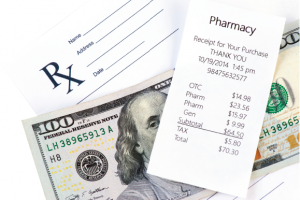
Sherry Yates Young / shutterstock.com
A patient with rheumatoid arthritis (RA) comes to your office and needs a medication. You prescribe it, and the patient’s insurance plan covers it. The patient begins the medication and slowly but surely feels better.
Prescribing drugs for a patient should be this simple but rarely is, thanks to the high cost of drugs and the variance in what insurance plans or Medicare cover.
Rheumatologists face questions about drug costs every day, and they are not always easy to answer. “Not infrequently, patients will ask if a drug is covered by their formulary,” says Allan Gibofsky, MD, Hospital for Special Surgery, and professor of medicine, Weill Cornell Medical College, New York. “When I make a drug decision, I may find out from the patient or staff that the drug is not covered, and we then look to prescribe something else. Sometimes that’s acceptable; sometimes it’s problematic, and we have to go through the appeals process.”
Drug-cost questions are particularly common for branded and newer drugs that treat RA, psoriatic arthritis and lupus, says Jonathan Greer, MD, president, Arthritis and Rheumatology Associates of Palm Beach, Palm Beach Gardens, Fla. However, even traditionally lower cost disease-modifying anti-rheumatic drugs (DMARDs) have had recent price increases and shortages, says Elizabeth Perkins, MD, Rheumatology Care Center, Birmingham, Ala.
Private insurance and Medicare patients each come with their own drug-cost issues that rheumatology practices must analyze and help manage.
The maze of prior authorization, insurance formularies and ever-changing drug costs has led rheumatologists to dedicate staff members to research the issue and keep patients up to date. It’s also led to frustration when rheumatologists get caught in the middle. Dr. Greer has had patients lash out at him when they haven’t received their medication. He checks in with staff, only to find out the prescription is still in process with the insurance company. “It’s very challenging,” he says.
The need for prior authorizations—and the paperwork and time they involve—has become more common in Dr. Greer’s experience.
The entry of biosimilars into the drug market adds a viable, but not always straightforward, option to lower drug costs, rheumatologists say. “So far, two infliximab biosimilars are available to rheumatologists, and they offer about a 15% discount compared with the bio-originator drug, Remicade,” says Angus B. Worthing, MD, FACP, FACR, Arthritis & Rheumatism Associates in the Washington, D.C., area, and chair of the ACR’s Government Affairs Committee. “It’s not clear that insurers are passing that savings on to patients, and some aren’t even covering the biosimilar. Clearly, we have a long way to go before patients realize savings.”
“Biosimilars may be priced lower than the reference biologic, but there will need to be better open access to the lower-cost alternative,” Dr. Perkins says.
Dr. Gibofsky envisions a time in the near future when some bio-originators will become lower in price to compete with biosimilars. “I haven’t yet seen a significant reduction in cost to the patient. It’s difficult to say to a patient, ‘I’m putting you on this drug to save money,’ when the savings aren’t realized by the patient,” he says.
The maze of prior authorization, insurance formularies & ever-changing drug costs has led … to frustration when rheumatologists get caught in the middle. Dr. Greer has had patients lash out at him when they haven’t received their medication.
What Patients Do to Cope
In a move to keep costs lower, rheumatologists have heard of patients who will use their prescribed drugs less frequently. “Patients with high yearly deductibles whose health is stable sometimes decide to forgo therapy in January, when the deductible renews and forces them to pay out of pocket,” Dr. Worthing says. “This often leads to disease flares weeks or months later.”
Some patients who do self-injections of subcutaneous medications will do those injections less frequently than recommended. “They’ll find that sweet spot when it’s only just a little uncomfortable. They’ll take a dose every five to six weeks instead of every four weeks,” Dr. Gibofsky says. “There’s nothing more frustrating than that seesaw pattern. We often counsel patients that you may feel well, but that’s not a reason to interrupt your medications. We may be able to do that on a formal basis, but I don’t advise spacing out medications on an informal basis.”
Another move seen by rheumatologists is a reliance on nonapproved therapies instead of expensive medications, Dr. Greer says. He has seen patients who have felt reasonably better using such products as turmeric, fish oil or glucosamine chondroitin. “Some have a good benefit from them, but they don’t control diseases of a destructive nature,” he says.
What can rheumatologists do to help patients who can’t always afford their medications?
8 Tips to Help with Medication Costs
1. Explain why the drug is needed. This may not change a patient’s economic situation, but it does give insight into the cost-vs.-benefit issue, Dr. Perkins says. “I explain to the patient what medications are indicated for their illness that may be more affordable and why those medications may or may not be right for them. These lower-cost retail medications and generics may still be costly to the patient. In addition, it is important they realize if they require an advanced therapy that we term a specialty medication—even though they are very expensive to the plan—that ways [exist] to lower their out-of-pocket expense.”
Dr. Perkins also explains that patients should not feel guilty if the drug they need is expensive. “They learn that their physician will pick the best medication for them,” she says.
2. Dedicate staff members to handle the issue. Although Dr. Greer is frustrated by the growing cost of medications and the complex maze of drug coverage, having dedicated medical assistants tasked to do prior authorizations has helped, he says. These medical assistants, along with business office staff at his private practice (with eight physicians and three locations), will navigate formularies and advise patients. They also can see if a patient needs a drug sample to sustain them until the medication they need is available.
3. Find out where to get lower-cost drugs. A website like GoodRx.com can help patients compare costs for medications and find where prices are lower, Dr. Worthing says.
Another option to consider for cost comparison is a mail-order pharmacy or medication service, says Judy Vobroucek, owner, Discount Med Direct, with locations in Florida, Illinois and Pennsylvania. The company is a medication service that requires a prescription and works with a network of pharmacies in the U.S. and around the globe. For thousands of medications—excluding biologics—the company usually finds prices that are 30–80% less expensive than retail. Examples of their typical prices within rheumatology include 90 pills of Plaquenil for $124.71 vs. $196 at a larger retail chain pharmacy. Another example is $322.70 for 3.2 mL syringes of Orthovisc vs. $1,366 at a larger retail pharmacy.
Discount Med Direct does not work with insurance, but many of its medication prices are cheaper than what is covered with insurance, Ms. Vobroucek says.
4. Help patients find coupons, copay cards and patient assistance programs. Ironically, these programs sometimes make branded products cheaper than generics, Dr. Gibofsky says.
Helping a patient determine if they qualify for a patient assistance program can be helpful, says health insurance agent Larry Medcalf, Indianapolis, and owner of MedCardMember.com. A good rule of thumb is that a patient’s household income must be below 300% of the federal poverty line to qualify, he says, adding, “You can google a federal poverty line chart for the current year to determine if the patient meets the guidelines.” (For 2018, 300% would equal $49,380 for two people in a household and $75,300 for four people.)
If they do qualify, they can fill out an application on the drug’s website, or they can use a database of applications available on NeedyMeds.org. “They will need to provide proof of income and a prescription. Once approved, the medications are usually mailed out quarterly to either the patient or their doctor’s office,” Mr. Medcalf says.
5. Consider generics—maybe. Generic costs are worth an inquiry, but they may not always be a viable option. Generic medications have saved patients money in the past, but that isn’t always the case anymore. “Paradoxically, some patients may pay more for relatively inexpensive generic small-molecule drugs like methotrexate, leflunomide or hydroxycholoroquine compared with more expensive biologics that offer copayment assistance,” Dr. Worthing says.
6. Encourage patients to ask pharmacies about better prices. “About 10 or 20% of the time our patients fill a prescription, they can save money by paying cash instead of paying a copay, because of the formulary arrangements made by pharmacy benefit managers (PBMs),” Dr. Worthing says. “The pharmacist is often ‘gagged’ [by law or agreements] from telling people this.” He advises rheumatologists advise patients to specifically ask if they can save by filling a prescription without using insurance and possibly with a GoodRx coupon instead.
Pharmacists will be empowered to inform people about these issues if the gag rule is lifted by active bills under consideration in Congress, Dr. Worthing says. At its May legislative fly-in event, the ACR supported the lifting of this gag rule, he adds.
7. Preach better lifestyle choices. Rheumatologists know that biologics are needed for chronic, incurable diseases they treat, such as RA, Dr. Worthing says. That said, healthier choices can make a positive difference for certain conditions.
“We go through sleep, exercise, diet, alcohol and tobacco every time I meet with a patient. These interventions can be just as important, and we can’t belittle that,” Dr. Greer says. He adds, for someone with gout, “dietary indiscretions” can exacerbate the disease, so better diet choices can help.
When medications are prescribed on the basis of weight, weight loss could potentially reduce the amount of medicine given and help lower costs slightly, Dr. Gibofsky says.
8. Speak up. Dr. Worthing plays an active role with the ACR in studying drug cost issues and shares his perspective on getting involved with drug pricing on the legislative side. “Rheumatologists can learn more and send a message to their elected officials at the ACR’s legislative action center. The Trump administration is currently considering several new policies to try to lower drug prices. Some might improve patients’ access to treatment—like ensuring that pharmacy benefit manager rebates are passed on to patients—but the ACR is very concerned about such proposals as increasing utilization management in Medicare or requiring doctors to participate in demonstration projects that limit use of medically necessary treatments.”
The Alliance for Transparent and Affordable Prescriptions is another resource rheumatologists can use to advocate for regulation of pharmacy benefit manager practices, Dr. Greer says.
“Recently, another janus kinase inhibitor launched at 60% lower than the leading anti-tumor necrosis factor medication, but it will have to be placed as a preferred agent to help with more affordable healthcare options,” Dr. Perkins says. “The pharmacy benefit managers will be key to the solution since they are not incentivized to fill the less expensive options.”
Looking Forward
The current challenges of matching patients with affordable medication makes rheumatologists look forward to future options.
“There is research currently going on that would enable us to select the appropriate drug for a given patient, resulting in less trial and error for various rheumatic diseases, such as RA. This is commonly called precision medicine and should lower costs for patients and insurers,” Dr. Greer says.
It’s also important for providers to stay determined to find coverage for the right treatment, according to Dr. Perkins. “The physician’s office and patient spend enormous time getting their therapy approved. Given these complexities of specialty pharmacies and opportunities for things to break down, it’s imperative the medical team emphasize to the patient to not give up, to call if there are problems with cost or medication delivery, and to realize there are always solutions to getting medication affordably,” she says.
Vanessa Caceres is a medical writer in Bradenton, Fla.



